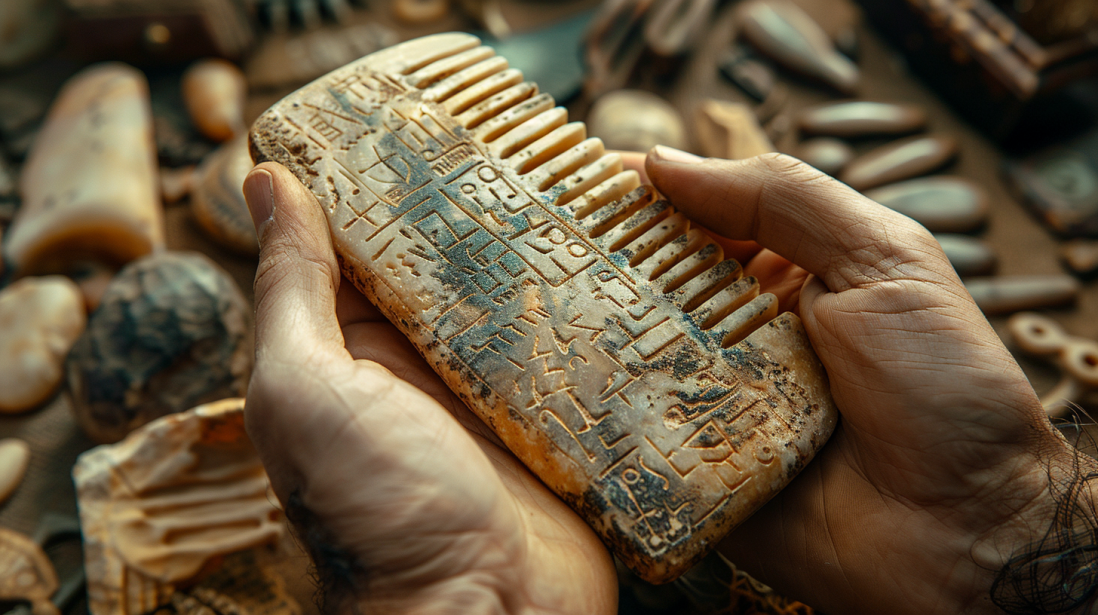Introduction
In a groundbreaking discovery, archaeologists have decoded the oldest known sentence written in the first alphabet. This sentence, found inscribed on a small ivory comb in Tel Lachish, Israel, dates back to around 1700 BCE. The inscription, written in the Canaanite script, translates to “May this tusk root out the lice of the hair and the beard,” reflecting a practical use of writing for everyday concerns. This remarkable find not only highlights the early use of alphabetic writing but also offers a glimpse into the daily life and hygiene practices of people living nearly 4,000 years ago.
The Discovery at Tel Lachish
Tel Lachish, an archaeological site in Israel, has been a rich source of ancient artifacts. Among the many discoveries, the small ivory comb stands out due to its significant inscription. Found in a city that was an important Canaanite center, this comb provides valuable evidence of early writing practices.
The Canaanite Script: The First Alphabet
The Canaanite script, believed to be the first alphabet, emerged around 1800 BCE. Unlike earlier writing systems like cuneiform and hieroglyphs, which used complex symbols and pictographs, the Canaanite script used a relatively small set of symbols to represent sounds, making it simpler and more versatile. This innovation laid the foundation for most modern alphabets.
Translation of the Inscription
The inscription on the comb has been meticulously translated by experts in ancient scripts. It reads: “May this tusk root out the lice of the hair and the beard.” This sentence is not only the oldest known example of alphabetic writing but also provides a practical glimpse into the concerns and daily life of the time.
Historical and Cultural Context
The period around 1700 BCE was a time of significant cultural and technological advancements in the ancient Near East. The development of alphabetic writing revolutionized communication, making it more accessible and efficient. This comb, with its practical inscription, exemplifies how writing was used for everyday needs, not just for monumental or ceremonial purposes.
Significance of the Ivory Comb
The ivory comb itself is a remarkable artifact. It is small, intricately carved, and made from a material that suggests it was a valued item. The choice of inscription indicates that lice infestation was a common problem, and the comb was likely a tool for personal grooming. The use of writing on such a mundane object underscores the spread and practical application of literacy in ancient societies.
Insights into Daily Life and Hygiene Practices
The comb’s inscription provides a direct link to the hygiene practices of people nearly 4,000 years ago. It reveals that lice were a common issue, and specific tools were created to address this problem. This insight adds depth to our understanding of ancient daily life, highlighting the continuity of human concerns across millennia.
Broader Implications for Understanding Ancient Writing
This discovery has broader implications for our understanding of ancient writing systems. It suggests that the use of alphabetic writing spread more widely and was adopted for various purposes much earlier than previously thought. It also highlights the ingenuity of ancient peoples in developing tools and systems to improve their daily lives.
The Impact of Alphabetic Writing
The invention of alphabetic writing was a turning point in human history. It simplified the process of learning to read and write, making literacy more attainable for larger segments of the population. This democratization of writing had profound effects on communication, record-keeping, and the transmission of knowledge.
Future Research and Discoveries
The discovery of the comb and its inscription opens new avenues for research. Archaeologists and linguists will continue to search for more examples of early alphabetic writing, aiming to build a more comprehensive understanding of its development and use. Each new find has the potential to shed further light on the evolution of written communication.
Conclusion
The decoding of the oldest known sentence written in the first alphabet is a landmark achievement in archaeology and linguistics. The inscription on the ivory comb from Tel Lachish offers a tangible connection to the past, revealing the practical uses of early writing and providing insights into the daily life and hygiene practices of ancient people. This discovery not only enriches our understanding of the Canaanite script but also underscores the enduring importance of written communication in human history.
FAQs
What is the oldest known sentence written in the first alphabet?
The oldest known sentence is inscribed on an ivory comb found in Tel Lachish, Israel. It reads: “May this tusk root out the lice of the hair and the beard.”
What is the Canaanite script?
The Canaanite script is considered the first alphabet, emerging around 1800 BCE. It used a small set of symbols to represent sounds, making writing simpler and more versatile.
What is the significance of the ivory comb?
The ivory comb is significant because it provides the oldest known example of alphabetic writing and offers insights into the daily life and hygiene practices of ancient people.
What does the inscription on the comb tell us about ancient life?
The inscription indicates that lice were a common problem and that specific tools were created to address it, highlighting concerns about hygiene in ancient times.
How does this discovery impact our understanding of ancient writing?
This discovery suggests that the use of alphabetic writing was more widespread and practical than previously thought, providing new insights into the development and application of early writing systems.
What are the broader implications of alphabetic writing?
The invention of alphabetic writing revolutionized communication, making literacy more accessible and improving the transmission of knowledge. This had profound effects on various aspects of society.

